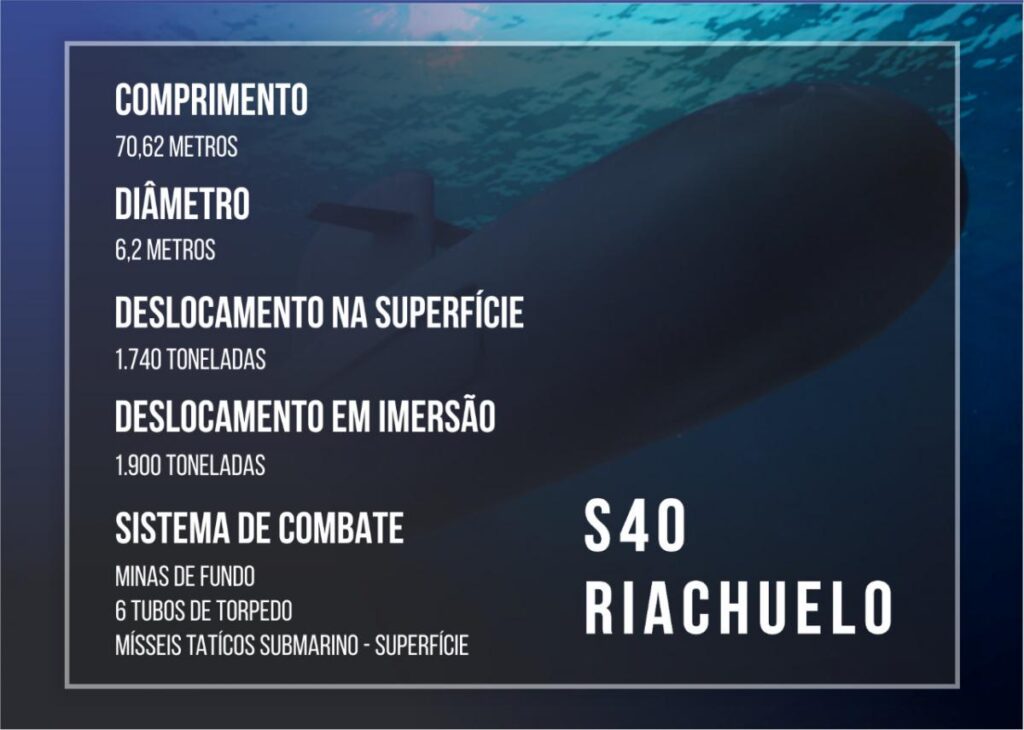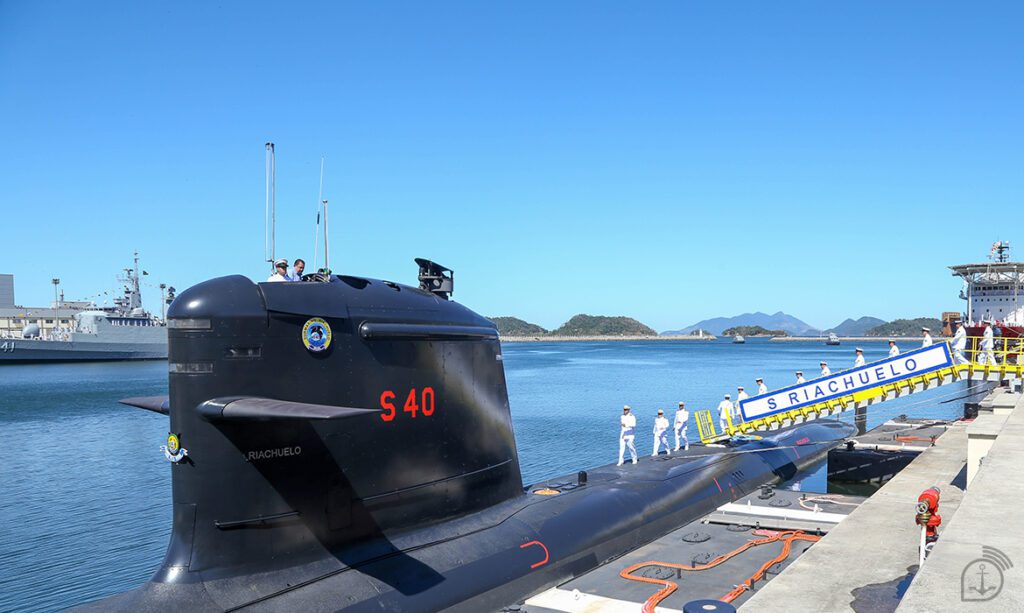Construction of the submarine allowed for technology transfer, the use of Brazilian labor and the development of national industry
By Second Lieutenant (RM2-T) Thaís Cerqueira Francisco – Itaguaí, RJ
Revolutionizing Brazilian technology and the naval industry, the Submarine Development Program (PROSUB) represents a significant technological advance in the country, based on intellectual capital, sensitive engineering, and cutting edge technology, in addition to encouraging defense policy, boosting personnel training, and strengthening national sovereignty. An important advance of PROSUB was the Armament Display of the Submarine (S40) “Riachuelo”, held today (1st), in Itaguaí (RJ).
The “Riachuelo” is the first of a class of four conventional submarines with diesel-electric propulsion, which will allow greater deterrence power in the 5.7 million km² of the Blue Amazon, whose rich waters, seabed and subsoil are important for economic, scientific and environmental development. It is in this maritime area that Brazilians develop fishing activities, where 95% of Brazilian foreign trade passes through and where biological and mineral resources are exploited.
To protect this heritage and ensure Brazilian sovereignty at sea, the Brazilian Navy (MB) invests in the expansion of naval strength, as is the case of the S40, an important element of surprise that is indispensable to deny enemy vessels access to national territory, increasing the deterrent power of the Brazilian Armed Forces. To achieve this effect, this type of ship takes advantage of its particular characteristics, notably its concealment capacity and its power to cause damage to adversary naval forces.
Present at the event, the Minister of Defense, Paulo Sérgio Nogueira de Oliveira, highlighted that the history of Brazil shows the participation of the MB in various decisive passages in the formation of the Brazilian nationality and that the delivery of the new naval means built in Brazil allows for an increase in the defense capacity in the maritime area known as the Blue Amazon. “The Submarine Development Program is of strategic importance to the country. The construction of these new submarines within the PROSUB program fulfills two major objectives: the improvement of the operational capacity of our Navy, with a considerable increase in its dissuasive power and the expansion of the protection of its jurisdictional waters, achieving a more effective presence in the South Atlantic; and also the increase of our naval industry and the development of new technologies, contributing to the promotion of the national economy with the creation of thousands of direct and indirect jobs.

The Navy Commander, Fleet Admiral Almir Garnier Santos, highlighted that “the Riachuelo represents an investment for the Brazilian society, in sovereignty, and in the wealth of the Brazilian people. More than 20 thousand direct jobs and about 40 thousand indirect jobs have already been generated. Besides this, the riches of our Blue Amazon are still incalculable. We are talking about something grandiose and extremely important for the future of our country.
According to the Commander of Naval Operations, Fleet Admiral Marcos Sampaio Olsen, the Submarine Force now has a class of quieter and more lethal submarines, prepared to act to guarantee the sovereignty of the Brazilian State. “Characteristics such as high discretion rate, increased detection capacity, and increased dwell time in patrol zones, in addition to precision and density in data acquisition in clarification and attack operations, make the arrival of the ‘Riachuelo’ Submarine one of the most awaited moments in recent years.”
For the Commander of the Submarine “Riachuelo”, Frigate Captain Edson do Vale Freitas, “the operational capabilities of the S40 make it capable of reducing the control exercised by the opponent, making it easier for the other forces to act. It also allows for mines, intelligence operations, and rescue or infiltration of special operations elements in enemy waters.
Riachuelo Class Submarines
Due to several technologies and innovations, the “Riachuelo” Class submarines (S-BR) are more versatile than the “Tupi” Class submarines (“Tupi”, “Tamoio”, “Timbira” and “Tapajó”) and are considered operationally superior to several submarines available in the world today.
They have advanced sensors – such as a sonar array and periscopes with night vision cameras – and a combat management system equipped with modern and complex algorithms that allow the submarine to detect and classify targets at long distances. The S-BR also has greater autonomy than its “Scorpène” class ancestor, due to a design change that included a midsection to increase accommodation and water tanks.


Through a technology transfer process, the construction of the S-BRs is being carried out by Brazilian labor (engineers and technicians) with technical assistance from the French company Naval Group. The Nationalization Program has already qualified around forty Brazilian companies for the manufacture of submarine components, in more than one hundred projects, the main ones being: the manufacture of the salt water valves by the company Micromazza, the manufacture of the batteries by the company NewPower and the manufacture of the strut bearing by the company Miba.
For the construction of the Brazilian conventional submarines and, in the future, the Conventionally Armed Submarine with Nuclear Propulsion “Álvaro Alberto”, a naval complex was built in Itaguaí that has several facilities, equipment and specialized systems. Today, it is one of the most modern shipyards in existence, since the construction of submarines requires highly skilled labor and an industrial park equipped to enable the execution of the various manufacturing, commissioning and testing activities. All this requires the integration of sophisticated technologies, following rigorous norms and standards of quality and safety.
“The Navy Nuclear Program is the backbone of the Brazilian Nuclear Program. We produce uranium pellets so that the Brazilian Nuclear Industries can keep Angra 1 and Angra 2 running, for example. The program allows for a dual use of this nuclear technology. Besides the military area, the pharmaceutical and food areas can also use this technology, providing technological, scientific and medical development to Brazil”, added the Navy Commander, after the ceremony.
Training the first crew

The training of the first crew lasted about two years and four months and was divided into three stages: preliminary, onshore, and onboard. In the preliminary training, the crew was submitted to theoretical exams and individual interviews. A Preliminary Training Plan was also prepared, executed by the Centro de Instrução e Adestramento Almirante Áttila Monteiro Aché.
The onshore and onboard training phases were carried out by instructors from Défense Conseil International, which is a partner company of the French Ministry of Defense, responsible for the international transfer of its military know-how to the Armed Forces of friendly countries. “We qualified in the submarine’s various systems and carried out exercises, with the purpose of making the crew autonomous in the safe conduct of the medium. At sea, training was given on how to steer the ‘Riachuelo’ and control breakdowns, so that everyone had the ability to perform their duties safely and skillfully,” reinforces the S40 Commander.
“Launched to sea for the first time in December 2018 and having executed its static immersion in November 2019, the Submarine ‘Riachuelo’ has since undergone an extensive program of acceptance tests at sea, on the surface and in immersion, so that today it could gain its soul – an experienced, ready and motivated crew that has also diligently prepared to receive it and to ensure the fulfillment of its mission,” highlighted the Chief of the Navy Staff, Admiral de Esquadra Renato Rodrigues de Aguiar Freire.
After the Armament Display, the Submarine “Riachuelo” will be submitted to the Commission of Inspection and Training Advisory, which will guarantee its full employment capacity. Afterwards, it will undergo Operational Evaluation, an important process for the establishment of operational parameters, which will serve as a basis for all units of the class, foreseen in the PROSUB scope.
The population will be able to see the new ship during the Naval and Naval Aviation Parade, which will take place in Rio de Janeiro (RJ), on September 7. During the event, three aircraft and 20 ships from the MB and other countries invited to the celebrations of the Bicentennial of Independence will run along the beachfront, starting at 9:30 a.m., starting at Recreio beach and ending at the Copacabana Fort.
Basic characteristics of the “Riachuelo

The Submarine “Riachuelo” has a total length of 70.62 meters, hull diameter of 6.2 meters, surface displacement of 1,740 tons and immersion displacement of 1,900 tons. Its combat system is equipped with six gun tubes, capable of launching heavy electro-acoustic torpedoes, tactical missiles of the submarine-surface type, and bottom mines.
The “Riachuelo” will be the seventh Navy ship to receive this name, in honor of the Naval Battle of Riachuelo, which occurred on June 11, 1865, during the Triple Alliance War. Besides the Submarine “Riachuelo”, the MB owns the Submarines “Tupi”, “Tamoio”, “Timbira”, and “Tapajó”, of the “Tupi” Class, and the Submarine “Tikuna”, of the Class of the same name.
*** Translated by the DEFCONPress Team ***
